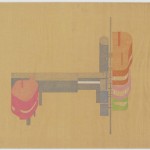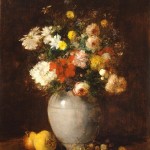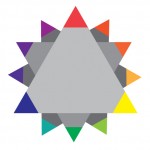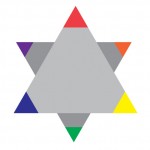Materials Needed
- all gouache paints from Supply List
- brushes, water containers, palette
- ruler, t-square, exacto knife
- pencils
- 9×12″ bristol
- Flashdrive or CD with your digital painting
Lecture
REVIEW
- Color Concepts and Vocabulary (See Classes 16 and 17)
Critique
Chromatic Gray Studies #1 & #2
Lab
Muted Color Studies PREP:
- Prepare 2 pieces of 9×12″ bristol by defining a 6×6″ square on each using your pencil and ruler.
- Muted colors, which range from just outside the Prismatic zone to the most saturated Chromatic Grays, are created by adding a chromatic dark, complementary color, or white to a prismatic color.
- You may have some tests from the last study that may have been too saturated to fit into the Chromatic Gray category- feel free to use them for this study.
Muted Color Studies – Exercise #1:
- Make a 6×6″ gouache, painted-paper collage using at least six shapes. All colors should be MUTED with a BROAD value range (light and dark) from a BROAD range of hues (colors). The white paper is not considered a color – the entire surface should be covered with paint.
- Use scrap pieces of bristol to create your painted paper shapes. Cut these out with scissors or exacto knife.
- Starting with a Prismatic Color (paint straight from the tube) add either the complementary color, white, or pre-mixed chromatic darks to achieve your range of muted colors. Adding white will create a lighter value, adding a pre-mixed chromatic dark or complementary color will create darker value.
- Arrange your shapes until you achieve a unified composition and then carefully glue down your pieces.
Muted Color Studies – Exercise #2:
- Make second 6×6″ gouache, painted-paper collage using at least six shapes. All colors should be MUTED with a NARROW value range (high, middle, or low key) from a broad range of hues (colors). The white paper is not considered a color – the entire surface should be covered with paint.
- IMPORTANT NOTES:
- Yellow and its adjacent hues can be used to create high-key muted color compositions. They cannot be darkened enough to reach low-key without losing saturation and becoming Chromatic Grays.
- Conversely, violet and its adjacent hues can not be lightened enough to reach the high-key value range without becoming Chromatic Grays.
- Violet, Blue and Green can be used to create low-key muted colors compositions.
HINTS:
- To prevent streaking, thoroughly mix paint before use, only adding enough water to get the consistency of cream.
- Wash and dry your brush on a paper towel after each use.
- At the end of your painting session, paint out any extra paint onto scrap bristol for future use.
- Use the technique demonstrated in class for gluing down your painted bristol shapes.
HOMEWORK
- Finish Muted Color Studies #1 & #2





